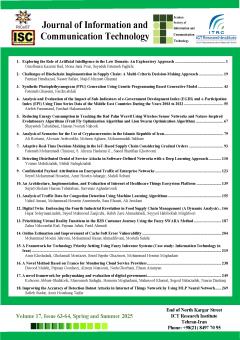An Architecture, Implementation, and Evaluation of Internet of Healthcare Things Ecosystem Platform
Subject Areas : ICTSayed Gholam Hassan Tabatabaei 1 * , sarvenaz aghadavoudi 2
1 - Department of Electrical & Computer Engineering, Malek-e-Ashtar University of Technology, Tehran, Iran
2 - Department of Electrical & Computer Engineering, Malek-e-Ashtar University of Technology, Tehran, Iran
Keywords: Internet of Things (IoT), 5G, Network Slicing, Cloud Computing, Software Defined Networking (SDN), Network Function Virtualization (NFV).,
Abstract :
Nowadays, healthcare delivery has shifted from in-person appointments with doctors to disease prediction through remote monitoring, and healthcare has shifted from a traditional hospital-centric approach to a distributed patient-centric approach. It is important to use the Internet of Things as a technology that can provide a distributed patient-centric approach. Providing an architecture and, consequently, a platform that can meet this need is very valuable for healthcare organizations and related institutions, because prevention costs are considered more economical for citizens and the government than treatment costs. To respond to the issues raised, a conceptual architecture based on the integration of IoT technologies, 5G, fog/edge computing, cloud computing, network slicing, software-defined networking, and network function virtualization has been presented for electronic monitoring of citizens' health. A variety of medical and environmental sensors have been used to monitor citizens and their environmental conditions in real time and over time; Therefore, the main goal of this research is to present an IoT technology ecosystem architecture in the health sector in order to improve the quality and level of health of citizens and respond to health issues as a cost-effective solution. The ecosystem is specific to the health sector and cannot be used in other sectors due to the provision of health network slices. The results obtained from evaluating the solution based on efficiency and scalability criteria indicate the desirability of the solution because the execution time for up to 100 nodes has been calculated to be less than 1 second. The architecture can be implemented and used on a large scale and at the same time maintain its appropriate efficiency. In the proposed solution, the risk of premature loss of life in citizens is reduced because by real-time monitoring of citizens without a history of illness and citizens with a history of illness under care in the event of a critical situation, the percentage of life losses will be reduced with timely assistance, and the result of using this solution will be in the interest of user organizations and institutions.
[1] A. Mukherjee, S. Ghosh, A. Behere, S. K. Ghosh, and R. Buyya, "Internet of health things (IoHT) for personalized health care using integrated edge-fog-cloud network," Journal of Ambient Intelligence and Humanized Computing, vol. 12, pp. 943-959, 2021.
[2] E. Kapassa et al., "An innovative ehealth system powered by 5G network slicing," in 2019 Sixth International Conference on Internet of Things: Systems, Management and Security (IOTSMS), 2019: IEEE, pp. 7-12.
[3] P. H. Vilela, J. J. Rodrigues, P. Solic, K. Saleem, and V. Furtado, "Performance evaluation of a Fog-assisted IoT solution for e-Health applications," Future Generation Computer Systems, vol. 97, pp. 379-386, 2019.
[4] A. H. Celdrán, M. G. Pérez, F. J. G. Clemente, F. Ippoliti, and G. M. Pérez, "Dynamic network slicing management of multimedia scenarios for future remote healthcare," Multimedia Tools and Applications, vol. 78, pp. 24707-24737, 2019.
[5] T. D. Mou and G. Srivastava, "Network Protocols for the Internet of Health Things," in Intelligent Internet of Things for Healthcare and Industry: Springer, 2022, pp. 21-66.
[6] S. Wijethilaka and M. Liyanage, "Survey on network slicing for Internet of Things realization in 5G networks," IEEE Communications Surveys & Tutorials, vol. 23, no. 2, pp. 957-994, 2021.
[7] R. Scott and D. Östberg, "A comparative study of open-source IoT middleware platforms," ed, 2018.

